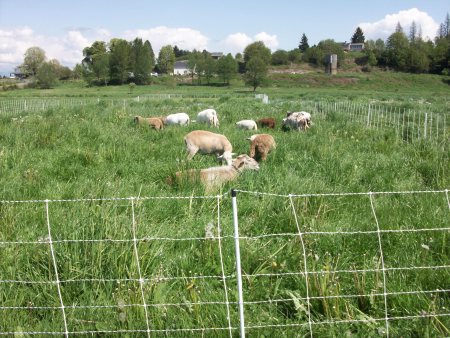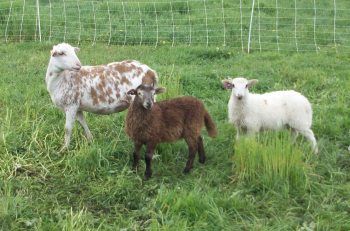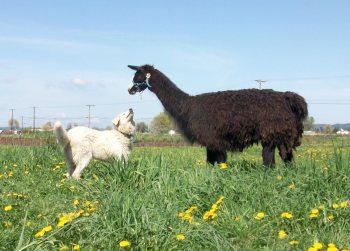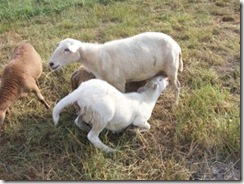 Well, not summer camp exactly. But I just got back from a four-day trip to Corvallis, OR to attend the Katahdin Hair Sheep International Expo and Sale. I really enjoyed it, they had great farm tours, speakers, and a sheep sale. I bought a few sheep too! I’ll try to write about the highlights, as best as I can capture all that I absorbed there.
Well, not summer camp exactly. But I just got back from a four-day trip to Corvallis, OR to attend the Katahdin Hair Sheep International Expo and Sale. I really enjoyed it, they had great farm tours, speakers, and a sheep sale. I bought a few sheep too! I’ll try to write about the highlights, as best as I can capture all that I absorbed there.
Category: Sheep
Sequestered Rams
 I have sequestered the rams to prevent them from breeding our ewes just yet. I have been racing against nature this summer to finish enough fencing to have a place to put them, and finished this paddock just in time- I could see one ewe coming into heat and them showing interest in her. Ewes generally start coming into heat when the days start getting shorter, so it was time.
I have sequestered the rams to prevent them from breeding our ewes just yet. I have been racing against nature this summer to finish enough fencing to have a place to put them, and finished this paddock just in time- I could see one ewe coming into heat and them showing interest in her. Ewes generally start coming into heat when the days start getting shorter, so it was time.
It’s not the end of the world if I have some breedings happen now, but I’m hoping to delay most of them until sometime in October. I haven’t picked an exact date yet. My plan is to have later spring lambs, and probably time them to come after daylight savings time, when it’s easier to do evening chores with a little more daylight.
My plan is to also separate them into two groups, so I can choose which ram sires which lambs next year. For now, they are hanging out with the llama in the pasture next door to the rest of the sheep.
Integrating Young Guardian Dogs With Sheep
As I mentioned in my previous post, I’ve been doing a lot of thinking and experimenting with training methods to harness our LGD’s talents and minimize her undesirable behaviors. The biggest challenge has been preventing her from getting rowdy with the sheep. She has affections for them, which does translate to guarding them. But it also translates, sometimes, into her wanting to engage them in a good game of wrestling, ala teenager dog style. This is injurious to the sheep, so obviously has to be prevented. Continue reading “Integrating Young Guardian Dogs With Sheep”
Livestock Guardian Dogs in America
 I really appreciate the below quote from the book Livestock Protection Dogs: Selection, Care, and Training by Orysia Dawydiak and David Sims. They capture well some of the thoughts I’ve been having about how to mold our young LGD into a good long-term sheep guardian.
I really appreciate the below quote from the book Livestock Protection Dogs: Selection, Care, and Training by Orysia Dawydiak and David Sims. They capture well some of the thoughts I’ve been having about how to mold our young LGD into a good long-term sheep guardian.
In Old World countries where livestock protection dogs have been traditionally used, lifestyles and farming practices are different than those we know in North America. Throughout Asia, the Middle East and the Mediterranean Basin, full-time shepherds are common. Sheep owners in a village often form communal flocks of sheep during the summer months when high country pastures can be used for grazing. Shepherd and livestock protection dogs accompany large bands of sheep to mountain meadows,. During these times when many protection dos are present, older dogs help to discipline and train younger ones. With one or more shepherds always on duty, undesirable behaviors can be spotted and corrected immediately. In this setting many stimuli act on a protection dog, including social interactions with other dogs. Boredom is unlikely to occur. If attacked or threatened by a predator, a protection do can reasonably expect to be backed up by his fellow pack members. He can also expect that a shepherd will be somewhere nearby, if not always in sight. …
Most North American farms would not fit into the scenario described above. Farms here have fenced pastures in lieu of open maintain rangelands. Livestock are moved abruptly from pasture to pasture, sometimes by truck.There are few full-time shepherds, goat herders, or cattle tenders. Protection dogs are often required to work along without aid or training from an experienced pack of peer dogs. Many protection dogs are initially placed with livestock that have learned to fear dogs. A significant part of the task of protection is having the confidence of the animals being guarded. North American guard dogs may be expected to develop their self-confidence with livestock that will run away from them or even show hostility. After a protection dog has gained the confidence of the flock or herd and has matured into a successful guardian, he is almost always left alone to perform what can be a very boring duty.
When such factors are considered, you may wonder why protection dogs transplanted from the tranquil mountains of Europe and Asia are able to work at all in the United States and Canada. Yet they do! The reason for their success is not so much the training techniques that are described in the succeeding chapters, but rather the highly evolved instincts of the dogs. If you have purchased a healthy protection breed puppy with an established guardian pedigree, he will probably become a good livestock guardian, in spite of any errors, you, the owner/trainer, might commit. In fact, you will never actually “train” your protection dog to protect. You will instead attempt to create an environment in which the dog is able to develop and express his inherited talents.
The challenges I’m observing and facing about our LGD are these: She has no “role model” of an experienced guardian dog to mimic, and there is no older dog, or me, out there 24/7 to scold her if she abuses the sheep. She sees the Border Collies, whom she admires, “chase” the sheep; and is somewhat inclined to mimic this behavior or try to join in. The sheep have learned to move for dogs, so they need to learn a new thing: which dogs to respect, and which dogs to ignore (and even further: eventually they need to learn to go to the LGD if they are fearful of something). Bronte was properly raised in a barn with sheep, so she is dearly bonded to them and has the capacity to walk and sit amongst them calmly. But her desire to treat them like peers gets her into trouble when she sometimes plays to rough with them, in the manner she would wrestle with another adolescent dog.
But, as the above quote points out, the situation is not hopeless. The goal is to create an environment where the dog can make good choices and learn desirable habits, so that over time, her guardian instincts will deploy in the manner I desire. I’ll try to write a bit about my training methods with her in the coming days, and how things have been going so far.
Growing Lambs and Storing Hay
Here is #10 and her ram lamb, who was born mid-January. He is almost as big as his mother! They are both doing an interesting second-shed- they shed out earlier, but are shedding again, down to a very, very short coat. Continue reading “Growing Lambs and Storing Hay”
New Electronet

I ordered two more rolls of Electronet from Premier. Now I have four 164′ sections of netting. Now, I can give the sheep a pretty big rectangle, and not have to move it so often. It also gives them a more comfortable grazing section, that’s not so cramped. I like for them to be able to do a bit of walking each day.
Weighing Lambs

This weekend I caught all the lambs individually. I wanted to trim their hooves and weigh them. Continue reading “Weighing Lambs”
Frozen Colostrum For The Future
 I only had one ewe single this year, but I took full advantage of that and milked colostrum out of her three times in the first twelve hours, to freeze for future use. The rest of the ewes had twins or triplets, so I didn’t want to rob any of them. Continue reading “Frozen Colostrum For The Future”
I only had one ewe single this year, but I took full advantage of that and milked colostrum out of her three times in the first twelve hours, to freeze for future use. The rest of the ewes had twins or triplets, so I didn’t want to rob any of them. Continue reading “Frozen Colostrum For The Future”
The Odd Couple: Ears, Eyes, Bark and Bite
 Here is our livestock guardian pair, displaying their somewhat adversarial relationship. Neither one is really afraid of the other, and they haven’t thus far hurt each other and don’t seem to have intent to. But, the dog enjoys getting some sport out of hassling the llama by barking at her, and leaping up to air-snap at her head. This annoys the llama to no end, and she swings her long neck around with flattened ears, trying to communicate her irritation. Sometimes she even spits at the dog, but the dog doesn’t mind and keeps at her lively sport. 🙂 Continue reading “The Odd Couple: Ears, Eyes, Bark and Bite”
Here is our livestock guardian pair, displaying their somewhat adversarial relationship. Neither one is really afraid of the other, and they haven’t thus far hurt each other and don’t seem to have intent to. But, the dog enjoys getting some sport out of hassling the llama by barking at her, and leaping up to air-snap at her head. This annoys the llama to no end, and she swings her long neck around with flattened ears, trying to communicate her irritation. Sometimes she even spits at the dog, but the dog doesn’t mind and keeps at her lively sport. 🙂 Continue reading “The Odd Couple: Ears, Eyes, Bark and Bite”


